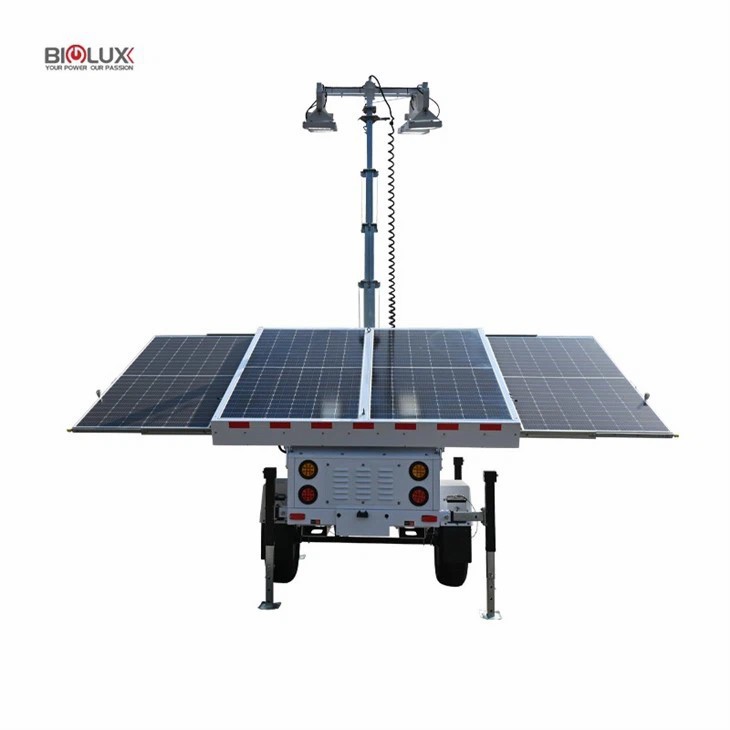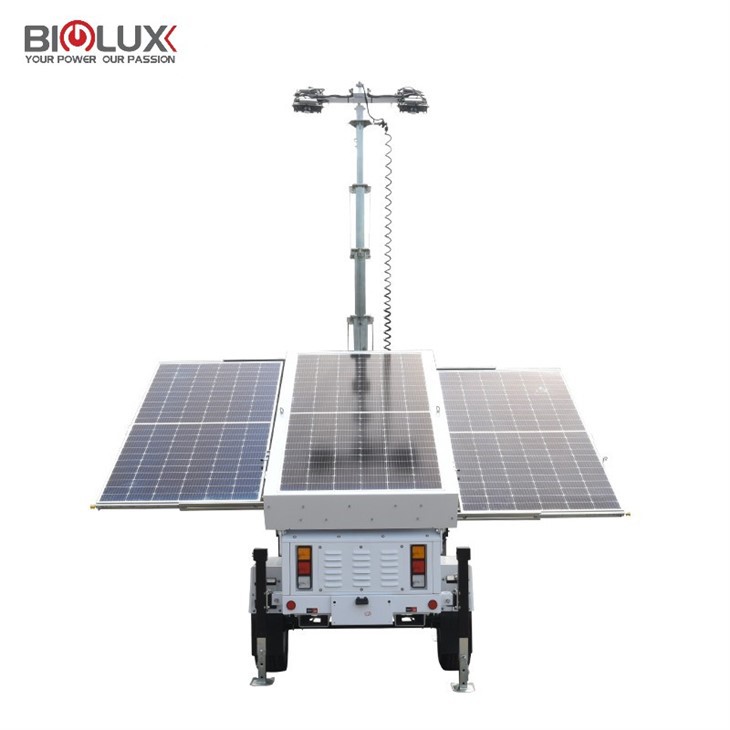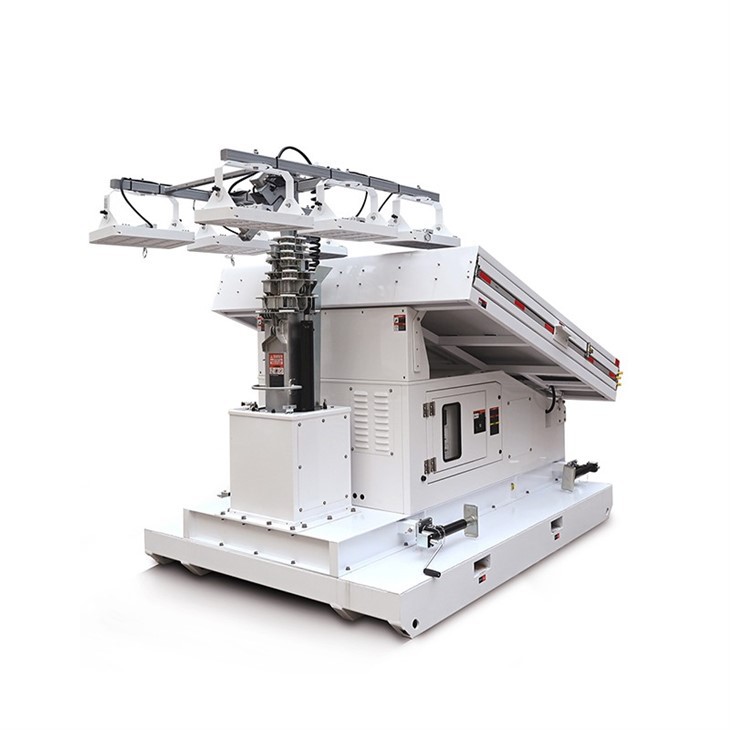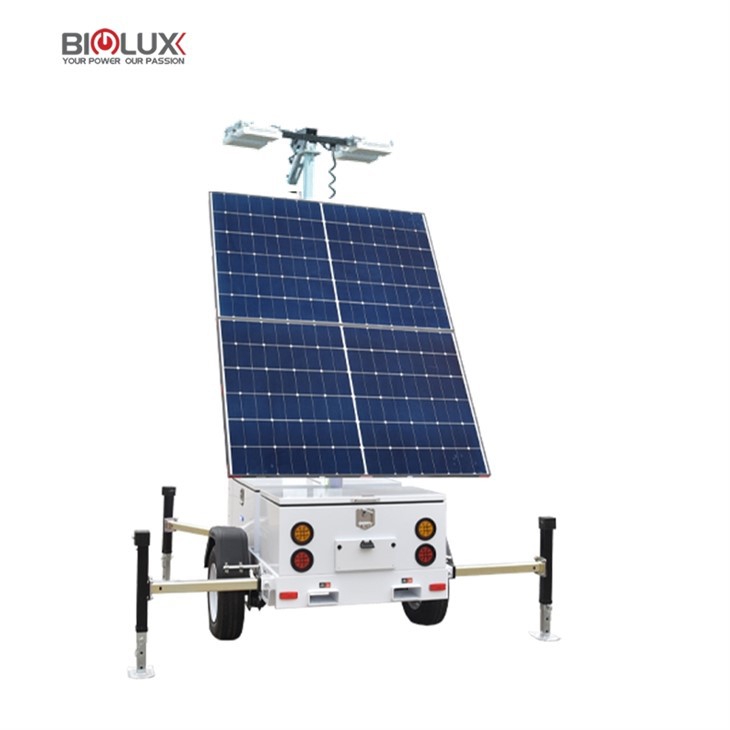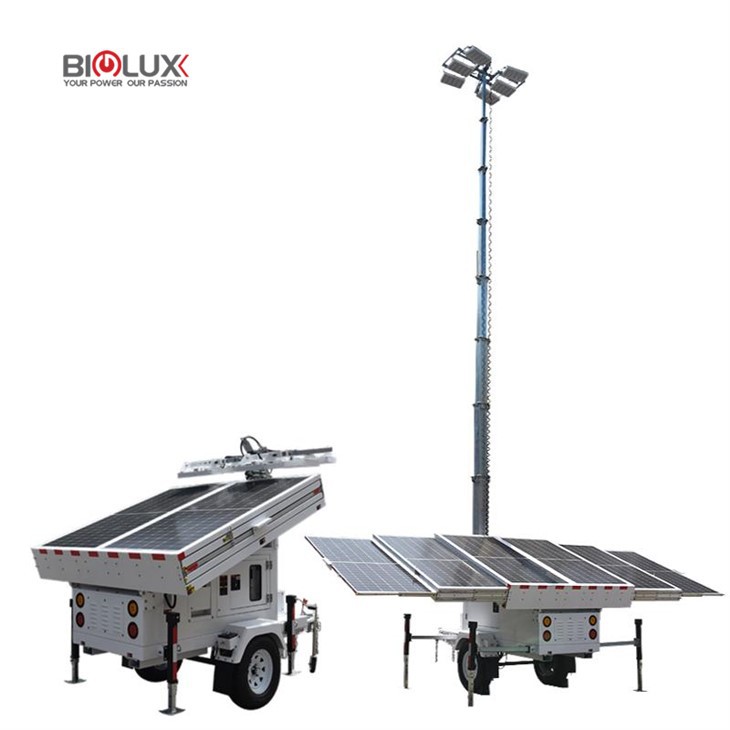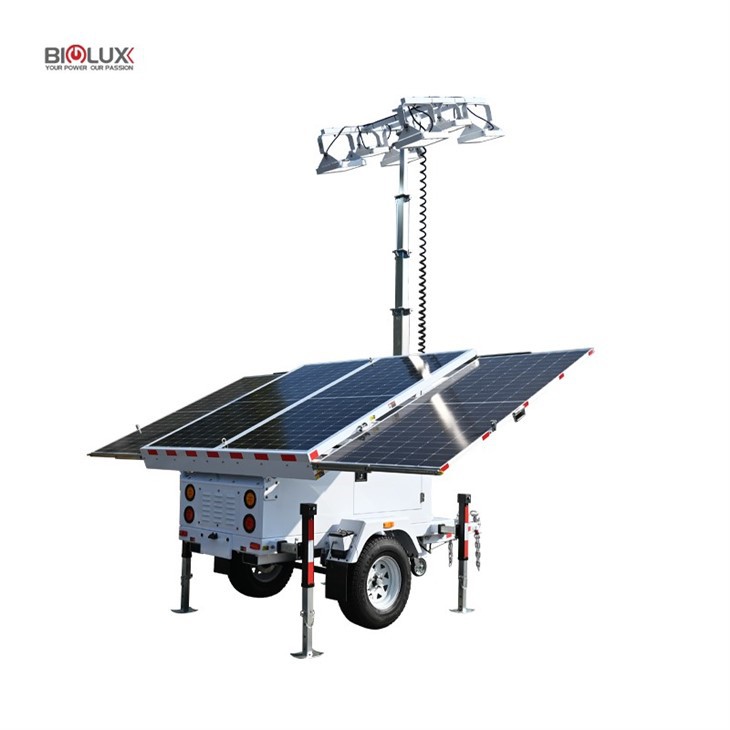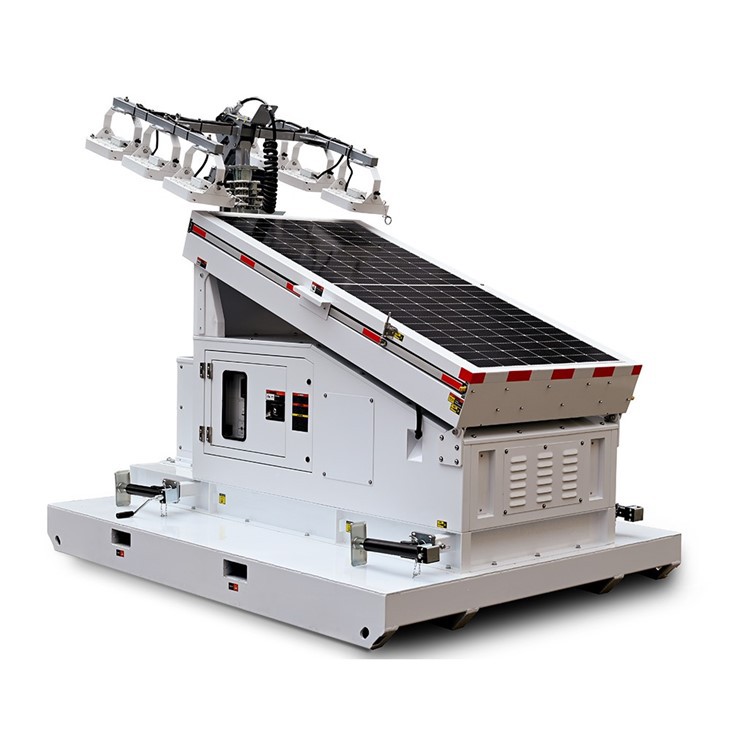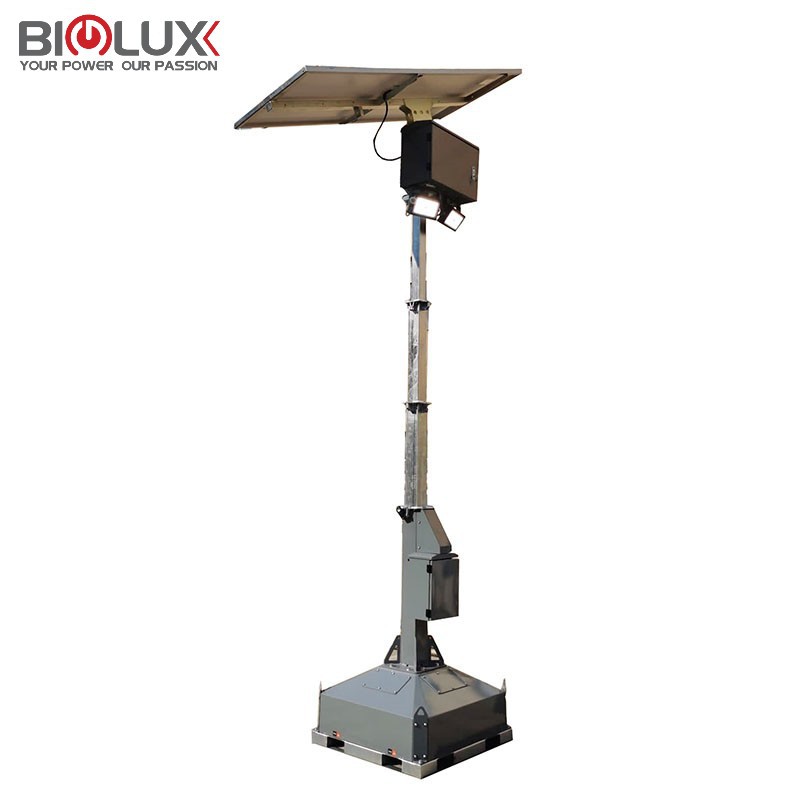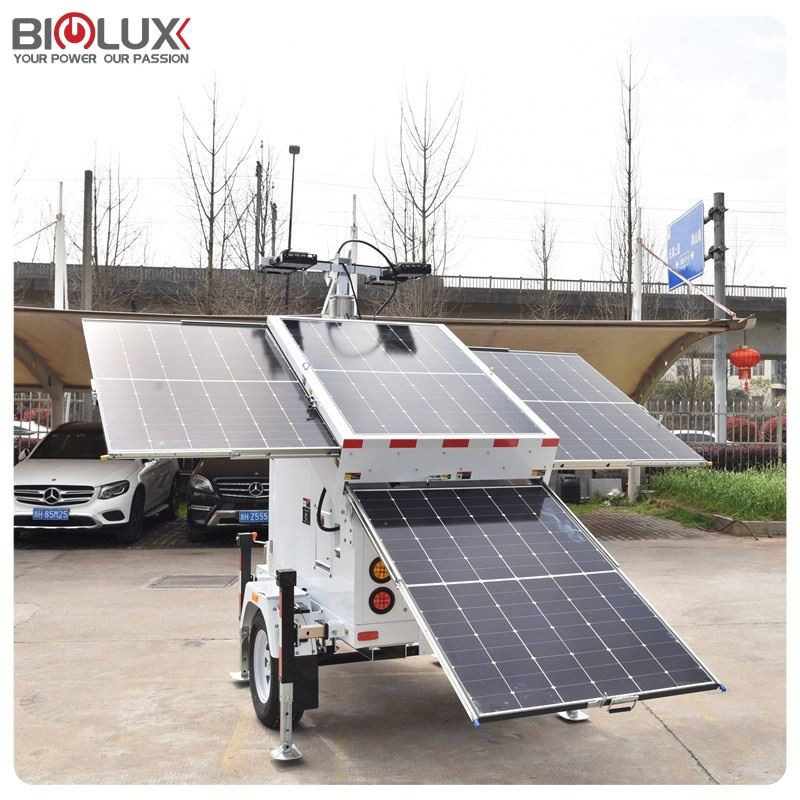A portable light tower is a versatile piece of mobile equipment with numerous uses. It has a mast and one or more high-intensity electric lights. The lights are usually attached to the mast, which is mounted on a mobile trailer with a generator set that supplies power to the electric bulbs. The lamps are usually metal halide bulbs, and the generator is usually powered by a diesel engine. There are also battery-powered, solar-powered, and hydrogen-powered lighting towers on the market. Even LED lighting towers are now on the market.
Biglux's mobile solar light towers are quiet, compact, powerful, and perfect for construction lighting, special events, and other types of work zones. As bright and effective as diesel towers and ready to use on your worksite with the same or a smaller compact footprint as diesel light towers, mobile solar light towers are the way to go.
Heavy Duty Mobile Solar Light Tower
As the official original manufacturer of solar light towers for the Qatar FIFA World Cup, BIGLUX provides the most professional and trustworthy solar system solutions. The Solar lighting tower Trailer with 3 solar panels is one of our most popular products on the world market.
HiSolo Mobile Solar Light Tower
Solar light towers are alternatives for traditional mobile light towers. The mobility is good and convenient for multiple applications, such as construction sites, parking lots, mine, etc.
Construction Site Mobile Solar Light Tower
These sites require mobile solar light towers to provide bright, energy-efficient illumination, essential for night work and low-light conditions, enhancing visibility and reducing accident risks.
This robust and versatile lighting solution is perfect for construction sites, large events, emergency response areas, and any situation where reliable and powerful illumination is required.
A solar Lighttower is a lighting device that uses solar energy. It has the advantages of energy saving, environmental protection, easy mobility and a wide range of applications.
Versatile and eco-friendly lighting solution that can be used anywhere, anytime.Designed to bring light to even the most remote and challenging areas, this cutting-edge trailer combines mobility, sustainability, and efficiency in one powerful package.
Whether it's a concert, festival, sports gathering, or outdoor party, these light towers provide reliable, energy-efficient, and eco-friendly lighting solutions. The advanced LED technology ensures powerful illumination while being cost-effective and easy to transport and set up.
T-type Design Mobile Solar Light Trailer
Mobile lighting solution that is powered by solar energy. These trailers are designed to provide portable and sustainable illumination for various applications, especially in locations where traditional power sources are not readily available or where temporary lighting is needed.
Better Illumination
With their powerful lights, portable light towers can illuminate a large area, allowing workers to see their surroundings clearly and perform their tasks more efficiently. This increased visibility boosts productivity and enhances safety by reducing the chances of accidents and injuries. Moreover, portable light towers are designed to be durable and weather-resistant, ensuring that they can withstand harsh conditions and continue to provide reliable lighting when needed most.
Versatility
These towers are portable, so they can be easily moved around the construction site as needed. They can also be adjusted to different heights and angles, making them versatile and adaptable to various situations.
Cost-Effective
Portable light towers are an affordable solution to lighting needs on a construction site. They are easy to set up and require minimal maintenance so that you can save on labour costs. They are also highly efficient, providing bright and even illumination that can easily cover large areas. This means you can get more work done in less time, improving productivity, reducing the risk of accidents and errors, and reducing costs even more!
Convenience
Portable light towers are a versatile and efficient solution for construction sites that require temporary lighting. These towers are specifically designed to be easily transported and set up, allowing workers to move them around the site as needed. They are also equipped with powerful lights that can illuminate a large area, providing ample visibility for workers to carry out their tasks safely.
Energy Efficient
Portable light towers are energy-efficient, using less fuel or electricity. This not only helps to reduce costs but also reduces the carbon footprint of the construction site. Portable light towers use LED lights, known for their energy efficiency and long lifespan. Unlike traditional lighting solutions that consume a lot of energy and need frequent replacements, LED lights are highly efficient and require minimal maintenance.
Durability
Most portable light towers are built to withstand harsh weather conditions and rough handling. They are often made of high-quality materials that can withstand impacts and vibrations like harsh weather conditions and heavy use, making them ideal for use on construction sites.
Improved Safety
Proper lighting is essential for ensuring the safety of workers on a construction site. Portable light towers provide bright, even lighting that can reduce the risk of accidents and injuries. They can also be used to illuminate hazardous areas, such as stairways and walkways, making them safer for workers to navigate.
Application of Portable Light Tower
Arrangements and shifting of Generator
The Generator will be placed on the trolley having wheels to fulfil the portability concept. Stainless steel racks and trays will be placed on that trolly to secure the cabling required to produce and use that light in different lamps placed on trolly or mast. So, ultimately, we can say the trolly with moving wheels will be shifted from one place to another as per the requirement.
Generate more electricity in the working area
It will play a vital role in choosing the type of portable light towers. In general, these portable light towers are manufactured under OSHA (Operational Safety and Health Administration). It assures the safety of people working under the mobile light towers. So, these portable light towers will generate the light more than the fixed poles light. These are designed to provide sufficient light, which will cover the whole working area.
Solar Panel
If the electric charged portable light tower is in use, then the charging cost will be less than others. Using time can be extended if manufacturers can use solar panels and electric charging set up in a single tower to use. These portable light towers can be used on the rental base also. No need to purchase them, and it will also be beneficial for the company cost.
Portable Light TowerSet Up– Dos & Don'ts


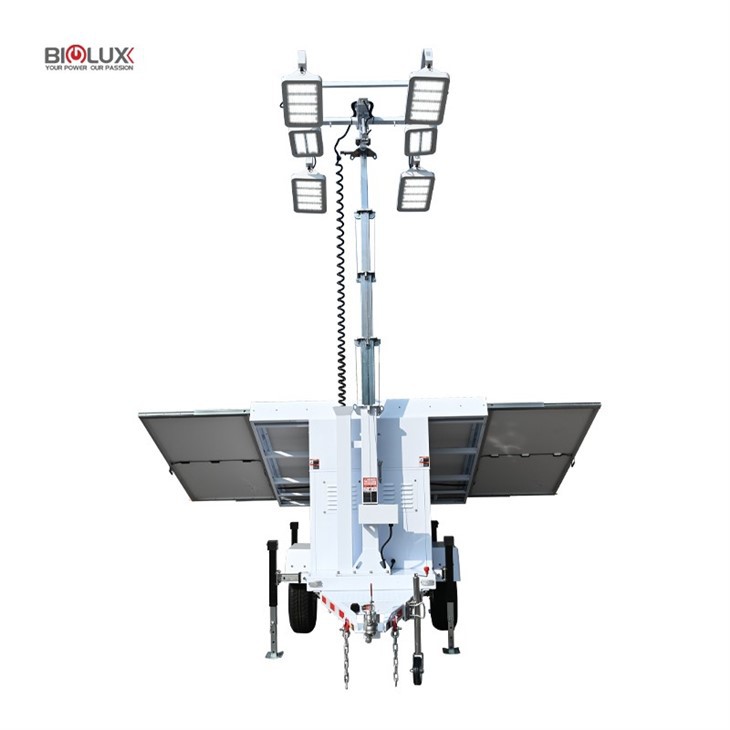

Before operating portable light towers, it's important to understand the basic rules of use. The first consideration you'll want to think about is whether a light tower or light tower/generator combination would be more appropriate for your job site. If you need both then a combination unit may eliminate the need for two machines.
Other options to consider relate to what kind of tower is most appropriate for the function. Some towers feature larger or more efficient fuel tanks than others so for projects needing longer run times, these may be more appropriate. Obviously any other job site restrictions should be considered before making your choice, such as any glare-free requirements, etc.
The first step to effectively using a portable light tower is proper set-up. This involves ensuring that you have proper clearance both around the unit and above, since the mast will be raised many feet upward. It's especially important that you have the proper clearance from above because power lines pose a significant safety risk.
- To raise the mast, remove the retaining pin and travel lock pin, turn the winch handle until the lower retaining bar locks in and then insert the retaining pin into the lower bar before extending the mast.
- To extend the mast, remove the retaining pin, pull the upper retaining bar and turn the extend/retract handle to extend.
- To retract the mast, rotate the mast and align the arrows, turn the extend/retract handle until the upper retaining bar locks into the mast and no red line is visible.
- To lower the mast, make sure the sections are retracted then pull the lower retaining bar, turn the winch handle and insert the travel lock pin and retaining pin, once fully lowered.
- To rotate the mast, release the mast rotation lock, rotate, and then tighten the handle to secure the mast. Remember that the mast must be aligned with arrows before retracting.
- Before moving a light tower, make sure that the mast has been properly lowered and retracted and stow the outriggers.
5 Tips for Renting a Portable Light Tower
Figure out how much coverage and brightness you need
Calculate the acreage you need to light and ask how many acres the light tower illuminates. Some can light up seven or even 10 acres.
Also, consider the level of brightness (lumens) you need. A construction jobsite has to be well lit so workers can see what they're doing - and even this requirement can vary according to the type of work they're doing. An audience area at a concert or sporting event, on the other hand, will not require the same level of brightness, since you want to keep attention focused on the stage or playing field.
Consider height and rotation
If you need height, check how high the mast can be extended and how easy it is to extend (winches may be manual or electric). Some masts extend as high as almost 30 feet. If the light tower needs to fit through a door, on the other hand, make sure it's small enough (height and width).
Because high winds can topple a tower and cause damage to people and property, make sure the light tower you choose has some kind of stabilization system; the best systems can keep the tower steady in winds up to 65 mph.
Choose between halide or LED
Many portable light towers today feature metal halide lights. These bright, warm lights can provide a great deal of illumination. However, they can take some time (5 to 10 minutes) to warm up before they reach their maximum output, and they don't turn off immediately; they have to cool down.
High-intensity, bright white LED lamps are a newer option. They are low-voltage and require less energy than metal halide lights, but they don't provide quite as much illumination. That means you'll need more lights to achieve the same level of lighting. LED lights are also more expensive than metal halides.
Weigh the power choices
Power options include diesel fuel, a generator, solar-charged batteries and, of course, a good old power outlet. If noise matters, keep in mind that solar and electric light towers are silent.
Light towers that run on diesel fuel contain their own tanks. Larger tanks provide longer uninterrupted running times, which means fewer potentially dangerous refills. Make sure the light tower includes a fluid containment system to reduce the chance of spills.
Towable or no
Consider how you will get the light tower to your site. Some portable light towers sit on a trailer that can go on highways or even, in the case of the most durable towable models, off-road.
Ultimately, when choosing a light tower, consider the adequacy of the illumination, the ease of setup and use, the noise and emissions levels, the efficiency of refueling and the safety of people and property.
A light tower is a significant investment for any project to be carried out after sunset. Therefore, you must take steps to ensure you get maximum value from your purchase. This can be done by:
- Conducting regular maintenance and repair checks on your light towers. This is best done after the lights shut down and cool.
- After use, turn the lights off individually before turning off the main breaker and shutting the engine. When you shut down the engine with the lights on, you increase the chances of failure of components.
- Use your light towers according to the manufacturer or supplier instructions.
- Choose a light tower with an integrated safety system that goes beyond the mandatory requirements. This minimizes risks of damage and injury to the crew if an accident occurs.
- Consider its portability and storage features even if using a light tower in one location. This ensures ease and efficiency in deployment throughout its lifetime.
- To ensure protection from harsh weather elements, especially in cold temperatures, check if it comes with a Cold Weather Package.
How to Choose the Right Portable Light Tower
Area of Coverage
The first thing to consider is the area where you will be using the light tower. The size of the area should determine the height of the mast and the intensity of the led lamps, white light, or bulbs you should use. A wide area, such as a large construction site, will need towers with very high masts and high-wattage bulbs for proper coverage.
Mobility
Some light towers are easier to move about than others. This is a very important factor to note, depending on how you will be using it on the site and how many light towers you will be deploying.
Power Source
The kind of power source the tower has is also something you should keep in mind, as it adds to the cost of operation. Light towers with an internal combustion engine require diesel or petrol to work. Depending on other factors, like the wattage of bulbs used and the model of the engine, more or less fuel may be consumed. Solar-powered light towers are eco-friendly but may have shorter running hours, compared to the units that are fuel-powered.
Buy or Rent
One other thing to consider is whether to buy or rent the light tower. Buying a light tower gives you complete freedom to use it as you like. But, unless you are using it frequently each year, the light tower may become a liability. That's because you would need to maintain it even when it's not in use. That is why the smarter option for occasional use is to rent a light tower. Renting a light tower allows you to use it for any purpose, without having to bother about maintenance or storage. This will save you both money and stress.
How To Use Portable Light Towers Effectively On Your Construction Site
The most common types of light towers adopted by construction sites are typically heavy trailer and portable small cart-like bases. Heavy trailers are powered by large engines, giving their light greater strength and coverage, but their weight and size make them better suited to endure tough environments where they will not need frequent transport. Towers with smaller, cart-like bases, however, are powered by lighter weight solar batteries, meaning they are far better for smaller construction sites with constant changes to layout.
If light is not covering the entirety of a work site, then progress of projects will be slowed by transport delays, failure to effectively conduct tasks, and accidents requiring attention. Contractors should therefore always calculate the amount of foot candles a construction site needs, as well as account for weather conditions changing quickly, influencing visibility. Rain in the late afternoon may also result in light towers being needed earlier than usual to ensure the site is adequately illuminated.
The safety of workers on-site is of the utmost importance to project managers. Positioning light towers in correct locations on site ensures all areas are bright while keeping everyone safe. A flat and stable surface is crucial for determining the right location for a light tower. If a tower is placed on unstable ground, the safety of workers will be compromised by the risk of falls. Overhead obstructions can cause just as many problems as unstable ground, and power lines and trees may also reduce the effectiveness of a light tower and cause safety issues.
Light towers with internal combustion engines powered by diesel or gasoline will require air and fuel filter checks regularly. The other important part of maintaining a light tower involves the bulbs. Metal Halide lamps will need to be replaced more frequently than LED lamps as they burn at higher temperatures. By choosing light towers with LED lamps, you will be saving time on regular maintenance of your light tower. Light towers are an essential part of any construction site. They ensure workers can complete their projects with maximum visibility so they do their jobs safely.
Why Choose Us
Perfect Quality Control
We have professional quality management and process inspection.
Fast Quality Service
All customers' needs are solved quickly during the service process.
Support Ability of Supply
We guarantee good product quality and sufficient quantity.
Excellent Cost Performance
Provide the best products with the best price and service.
Our Certifications
Innovation encompasses many breakthroughs thought when managing all aspects of its product design and development processes. We devoted to leading to the industry.


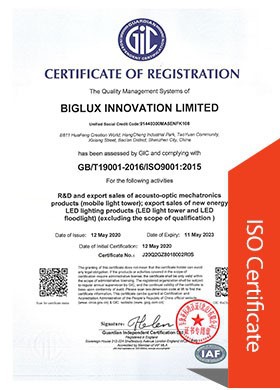
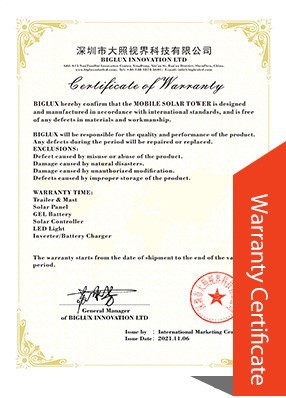

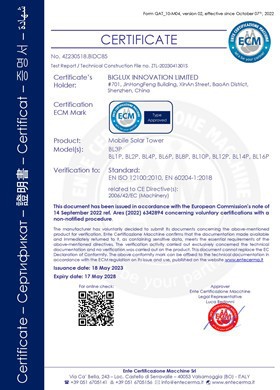
Our Factory
BIGLUX develops and implements specific & innovative mobile solar power and mobile solar generator solutions for different commercial and industry applications. By adopting the latest renewable energy technology, BIGLUX integrated solar and LFP battery system to develops and implements the most energy saving renewable mobile solar systems to work as solar light tower, solar CCTV tower and mobile power solution for outdoor parking lot, outdoor sports, events, construction site, work site, data base, military base and emergency applications etc.
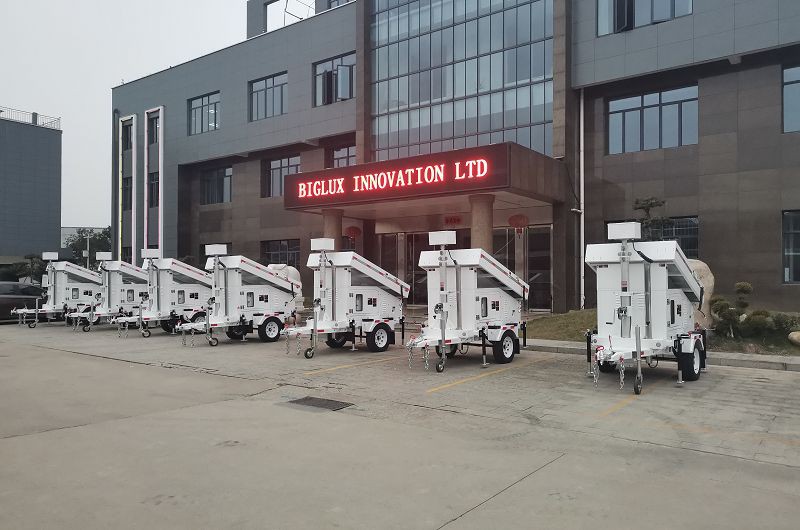
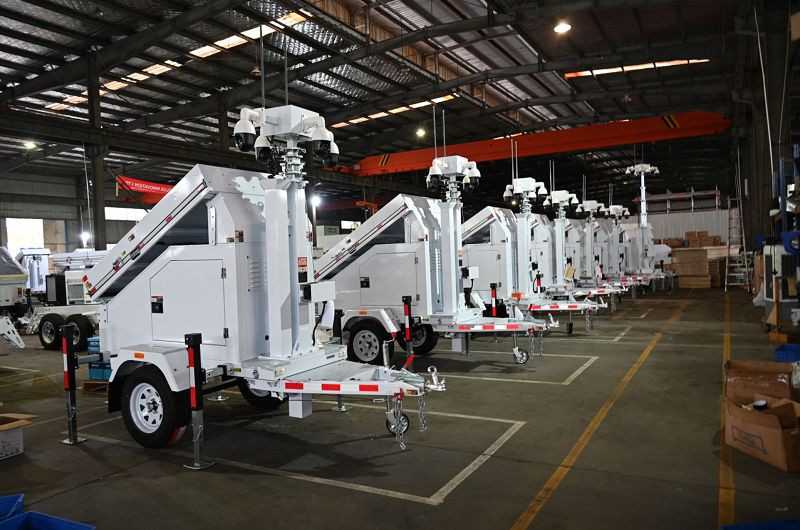
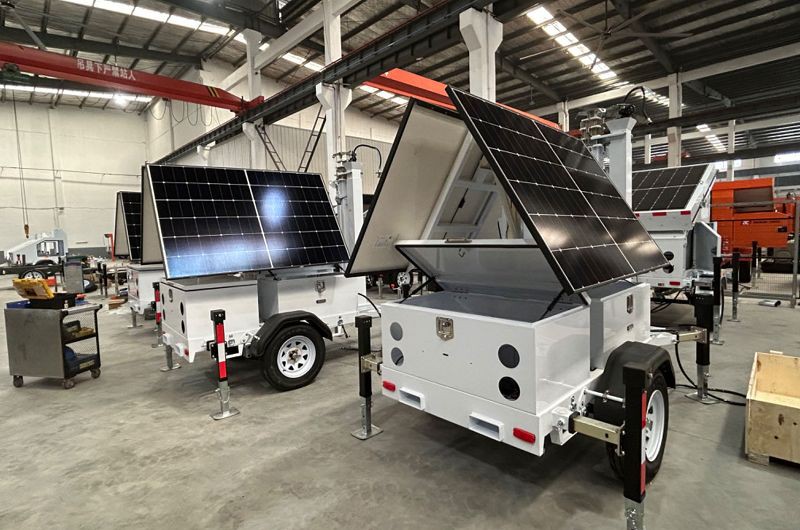
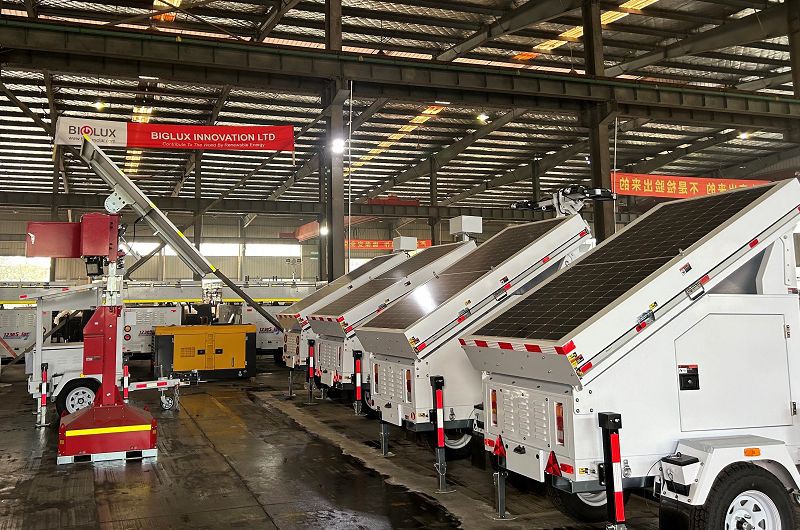

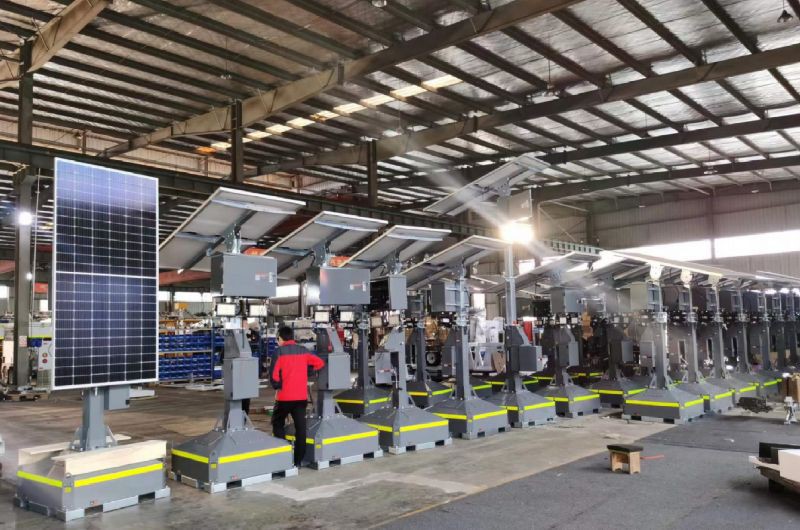
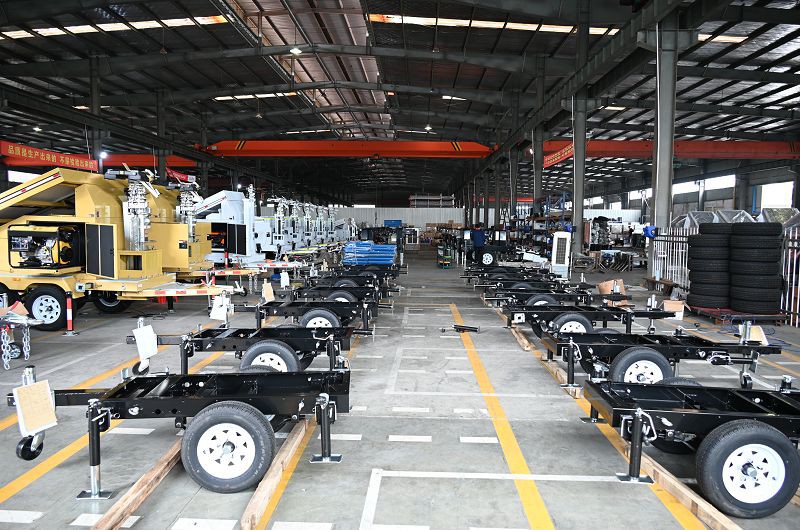
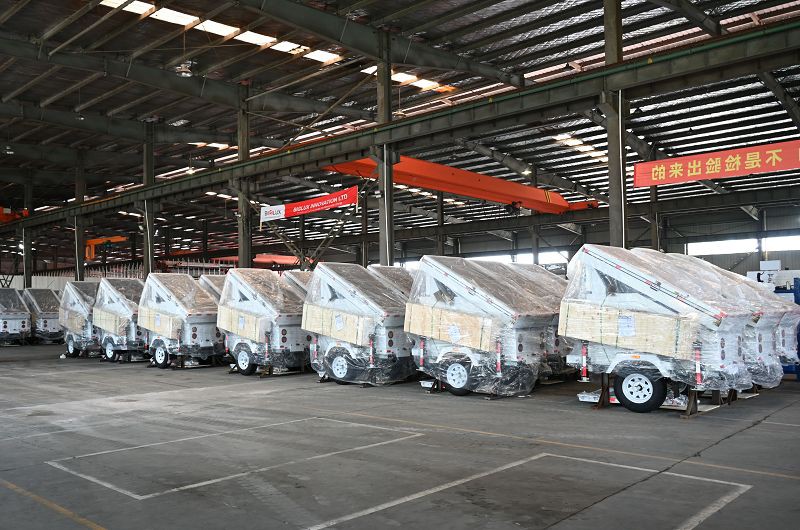
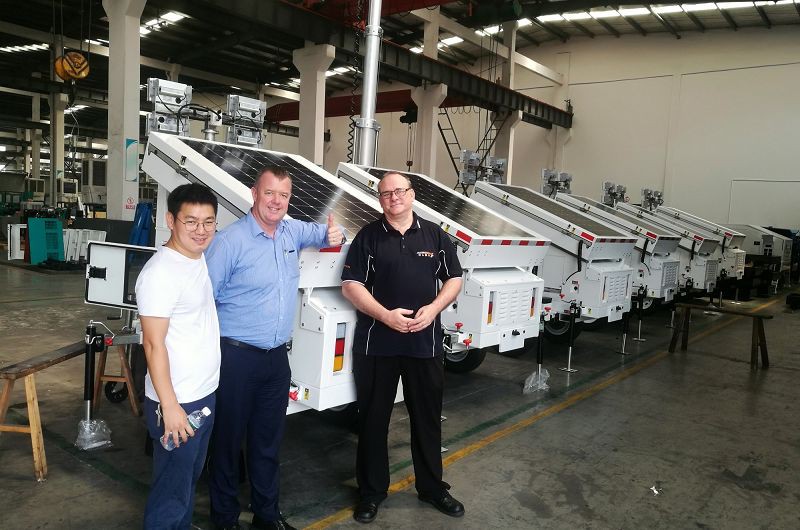
Ultimate FAQ Guide to Portable Light Tower
Q: Do light towers need to be grounded?
Q: How many light towers do I need?
Q: How do lighting towers work?
Q: What is the distance between light towers?
Q: How long will a light tower run?
Q: What is the use of mobile light tower?
Q: What should be the distance between two mobile towers?
Q: Do light towers have outlets?
Q: How fast can you tow a light tower?
Q: Can a light tower be used as a generator?
Q: What is the life expectancy of a light tower?
Q: How much area will a light tower cover?
Q: What is the voltage of a light tower?
Q: Who uses light towers?
Q: How many lumens do I need for a portable work light?
Q: Do portable light towers need to be grounded?










